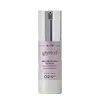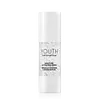What's inside
What's inside
 Key Ingredients
Key Ingredients

 Benefits
Benefits

 Concerns
Concerns

 Ingredients Side-by-side
Ingredients Side-by-side

Water
Skin ConditioningGlycerin
HumectantPolysorbate 20
EmulsifyingPentylene Glycol
Skin ConditioningPropanediol
SolventPanthenol
Skin ConditioningCarbomer
Emulsion StabilisingMucor Miehei Extract
AstringentButylene Glycol
HumectantPhenoxyethanol
PreservativeCaprylyl Glycol
EmollientSodium Hydroxide
BufferingCitrus Limon Peel Oil
MaskingEthylhexylglycerin
Skin ConditioningHexylene Glycol
EmulsifyingAcetyl Hexapeptide-8
HumectantPalmitoyl Tripeptide-1
Skin ConditioningPalmitoyl Tetrapeptide-7
Skin ConditioningGlycine
BufferingSorbitol
HumectantHydrolyzed Soy Protein
HumectantSodium Hyaluronate
HumectantOlea Europaea Leaf Extract
PerfumingCarica Papaya Fruit Extract
Skin ConditioningCamellia Sinensis Leaf Extract
AntimicrobialVitis Vinifera Seed Extract
AntimicrobialMoringa Oleifera Seed Oil
EmollientVitis Vinifera Seed Oil
EmollientTocopherol
AntioxidantTetrahexyldecyl Ascorbate
AntioxidantCitrus Aurantifolia Peel Oil
MaskingHexanoyl Dipeptide-3 Norleucine Acetate
Skin ConditioningLecithin
EmollientMica
Cosmetic ColorantTitanium Dioxide
Cosmetic ColorantCopper Tripeptide-1
Skin ConditioningDimethyl Mea
BufferingAcid Blue 9
Cosmetic ColorantCI 19140
Cosmetic ColorantWater, Glycerin, Polysorbate 20, Pentylene Glycol, Propanediol, Panthenol, Carbomer, Mucor Miehei Extract, Butylene Glycol, Phenoxyethanol, Caprylyl Glycol, Sodium Hydroxide, Citrus Limon Peel Oil, Ethylhexylglycerin, Hexylene Glycol, Acetyl Hexapeptide-8, Palmitoyl Tripeptide-1, Palmitoyl Tetrapeptide-7, Glycine, Sorbitol, Hydrolyzed Soy Protein, Sodium Hyaluronate, Olea Europaea Leaf Extract, Carica Papaya Fruit Extract, Camellia Sinensis Leaf Extract, Vitis Vinifera Seed Extract, Moringa Oleifera Seed Oil, Vitis Vinifera Seed Oil, Tocopherol, Tetrahexyldecyl Ascorbate, Citrus Aurantifolia Peel Oil, Hexanoyl Dipeptide-3 Norleucine Acetate, Lecithin, Mica, Titanium Dioxide, Copper Tripeptide-1, Dimethyl Mea, Acid Blue 9, CI 19140
Water
Skin ConditioningPrunus Amygdalus Dulcis Oil
Skin ConditioningPropanediol
SolventDipentaerythrityl Hexacaprylate/Hexacaprate
EmulsifyingGlycerin
HumectantButylene Glycol
HumectantSorbitol
HumectantOpuntia Tuna Flower/Stem Extract
Skin ConditioningHydrolyzed Sodium Hyaluronate
Skin ConditioningSodium Acetylated Hyaluronate
HumectantSodium Hyaluronate
HumectantSodium Hyaluronate Crosspolymer
HumectantSqualane
EmollientLotus Japonicus Symbiosome Extract
AntioxidantSchisandra Chinensis Fruit Extract
Skin ConditioningMalus Domestica Fruit Cell Culture Extract
Skin ConditioningVitis Rotundifolia Fruit Extract
Skin ConditioningTocopheryl Acetate
AntioxidantPanthenol
Skin ConditioningMagnesium Ascorbyl Phosphate
AntioxidantVitis Vinifera Seed Extract
AntimicrobialBeta-Glucan
Skin ConditioningEugenia Caryophyllus Leaf Oil
MaskingLinoleic Acid
CleansingLecithin
EmollientPhytosteryl Canola Glycerides
Skin ConditioningOleic Acid
EmollientPalmitic Acid
EmollientBetaine
HumectantAcrylates/C10-30 Alkyl Acrylate Crosspolymer
Emulsion StabilisingCarrageenan
Cellulose Gum
Emulsion StabilisingEthylhexylglycerin
Skin ConditioningSodium Hydroxide
BufferingCaprylic/Capric Triglyceride
MaskingLactobacillus/Soybean Ferment Extract
Skin ConditioningViscum Album Leaf Extract
SoothingAcacia Decurrens Extract
AstringentPentylene Glycol
Skin ConditioningImperata Cylindrica Root Extract
Skin Conditioning1,2-Hexanediol
Skin ConditioningCaprylyl Glycol
EmollientXanthan Gum
EmulsifyingPhenoxyethanol
PreservativeStearic Acid
CleansingTriolein
Skin ConditioningSuperoxide Dismutase
AntioxidantCananga Odorata Flower Oil
MaskingCoriandrum Sativum Fruit Oil
MaskingEugenol
PerfumingLinalool
PerfumingWater, Prunus Amygdalus Dulcis Oil, Propanediol, Dipentaerythrityl Hexacaprylate/Hexacaprate, Glycerin, Butylene Glycol, Sorbitol, Opuntia Tuna Flower/Stem Extract, Hydrolyzed Sodium Hyaluronate, Sodium Acetylated Hyaluronate, Sodium Hyaluronate, Sodium Hyaluronate Crosspolymer, Squalane, Lotus Japonicus Symbiosome Extract, Schisandra Chinensis Fruit Extract, Malus Domestica Fruit Cell Culture Extract, Vitis Rotundifolia Fruit Extract, Tocopheryl Acetate, Panthenol, Magnesium Ascorbyl Phosphate, Vitis Vinifera Seed Extract, Beta-Glucan, Eugenia Caryophyllus Leaf Oil, Linoleic Acid, Lecithin, Phytosteryl Canola Glycerides, Oleic Acid, Palmitic Acid, Betaine, Acrylates/C10-30 Alkyl Acrylate Crosspolymer, Carrageenan, Cellulose Gum, Ethylhexylglycerin, Sodium Hydroxide, Caprylic/Capric Triglyceride, Lactobacillus/Soybean Ferment Extract, Viscum Album Leaf Extract, Acacia Decurrens Extract, Pentylene Glycol, Imperata Cylindrica Root Extract, 1,2-Hexanediol, Caprylyl Glycol, Xanthan Gum, Phenoxyethanol, Stearic Acid, Triolein, Superoxide Dismutase, Cananga Odorata Flower Oil, Coriandrum Sativum Fruit Oil, Eugenol, Linalool
Ingredients Explained
These ingredients are found in both products.
Ingredients higher up in an ingredient list are typically present in a larger amount.
Butylene Glycol (or BG) is used within cosmetic products for a few different reasons:
Overall, Butylene Glycol is a safe and well-rounded ingredient that works well with other ingredients.
Though this ingredient works well with most skin types, some people with sensitive skin may experience a reaction such as allergic rashes, closed comedones, or itchiness.
Learn more about Butylene GlycolCaprylyl Glycol is a humectant and emollient, meaning it attracts and preserves moisture.
It is a common ingredient in many products, especially those designed to hydrate skin. The primary benefits are retaining moisture, skin softening, and promoting a healthy skin barrier.
Though Caprylyl Glycol is an alcohol derived from fatty acids, it is not the kind that can dry out skin.
This ingredient is also used as a preservative to extend the life of products. It has slight antimicrobial properties.
Learn more about Caprylyl GlycolEthylhexylglycerin (we can't pronounce this either) is commonly used as a preservative and skin softener. It is derived from glyceryl.
You might see Ethylhexylglycerin often paired with other preservatives such as phenoxyethanol. Ethylhexylglycerin has been found to increase the effectiveness of these other preservatives.
Glycerin is already naturally found in your skin. It helps moisturize and protect your skin.
A study from 2016 found glycerin to be more effective as a humectant than AHAs and hyaluronic acid.
As a humectant, it helps the skin stay hydrated by pulling moisture to your skin. The low molecular weight of glycerin allows it to pull moisture into the deeper layers of your skin.
Hydrated skin improves your skin barrier; Your skin barrier helps protect against irritants and bacteria.
Glycerin has also been found to have antimicrobial and antiviral properties. Due to these properties, glycerin is often used in wound and burn treatments.
In cosmetics, glycerin is usually derived from plants such as soybean or palm. However, it can also be sourced from animals, such as tallow or animal fat.
This ingredient is organic, colorless, odorless, and non-toxic.
Glycerin is the name for this ingredient in American English. British English uses Glycerol/Glycerine.
Learn more about GlycerinLecithin is a term for a group of substances found in the cell membranes of plants, animals, and humans. They are made up of mixture of phospholipids.
This ingredient has emollient and emulsifying properties.
As an emollient, lecithen helps soften the skin and creates a barrier to keep moisture in.
As an emulsifier, it also helps prevent water and oil ingredients from separating. Lecithin can also help ingredients be better absorbed by the skin.
This is because the phospholipids in lecithin produce liposomes. Liposomes help other ingredients get through the skin barrier.
Depending on the source of this ingredient, lecithin may not be fungal acne safe. This is because some sources of lecithin come from soybean oil, which may feed the malassezia yeast that feeds fungal acne.
We recommend reaching out to the brand you are purchasing from to inquire about the source of their lecithin.
Some other names for this ingredient include soy lecithin and deoiled soy lecithin.
Learn more about LecithinPanthenol is a common ingredient that helps hydrate and soothe the skin. It is found naturally in our skin and hair.
There are two forms of panthenol: D and L.
D-panthenol is also known as dexpanthenol. Most cosmetics use dexpanthenol or a mixture of D and L-panthenol.
Panthenol is famous due to its ability to go deeper into the skin's layers. Using this ingredient has numerous pros (and no cons):
Like hyaluronic acid, panthenol is a humectant. Humectants are able to bind and hold large amounts of water to keep skin hydrated.
This ingredient works well for wound healing. It works by increasing tissue in the wound and helps close open wounds.
Once oxidized, panthenol converts to pantothenic acid. Panthothenic acid is found in all living cells.
This ingredient is also referred to as pro-vitamin B5.
Learn more about PanthenolPentylene glycol is typically used within a product to thicken it. It also adds a smooth, soft, and moisturizing feel to the product. It is naturally found in plants such as sugar beets.
The hydrophilic trait of Pentylene Glycol makes it a humectant. As a humectant, Pentylene Glycol helps draw moisture from the air to your skin. This can help keep your skin hydrated.
This property also makes Pentylene Glycol a great texture enhancer. It can also help thicken or stabilize a product.
Pentylene Glycol also acts as a mild preservative and helps to keep a product microbe-free.
Some people may experience mild eye and skin irritation from Pentylene Glycol. We always recommend speaking with a professional about using this ingredient in your routine.
Pentylene Glycol has a low molecular weight and is part of the 1,2-glycol family.
Learn more about Pentylene GlycolPhenoxyethanol is a preservative that has germicide, antimicrobial, and aromatic properties. Studies show that phenoxyethanol can prevent microbial growth. By itself, it has a scent that is similar to that of a rose.
It's often used in formulations along with Caprylyl Glycol to preserve the shelf life of products.
Propanediol is an all-star ingredient. It softens, hydrates, and smooths the skin.
It’s often used to:
Propanediol is not likely to cause sensitivity and considered safe to use. It is derived from corn or petroleum with a clear color and no scent.
Learn more about PropanediolSodium Hyaluronate is hyaluronic acid's salt form. It is commonly derived from the sodium salt of hyaluronic acid.
Like hyaluronic acid, it is great at holding water and acts as a humectant. This makes it a great skin hydrating ingredient.
Sodium Hyaluronate is naturally occurring in our bodies and is mostly found in eye fluid and joints.
These are some other common types of Hyaluronic Acid:
Learn more about Sodium HyaluronateSodium Hydroxide is also known as lye or caustic soda. It is used to adjust the pH of products; many ingredients require a specific pH to be effective.
In small amounts, sodium hydroxide is considered safe to use. However, large amounts may cause chemical burns due to its high alkaline.
Your skin has a natural pH and acid mantle. This acid mantle helps prevent harmful bacteria from breaking through. The acid mantle also helps keep your skin hydrated.
"Alkaline" refers to a high pH level. A low pH level would be considered acidic.
Learn more about Sodium HydroxideSorbitol is a sugar alcohol. It is a hydrating and moisturizing agent created from the reduction process of glucose.
Most sorbitol is usually made from potato starch. It is also found in fruits such as apples and pears.
As a humectant, Sorbitol helps draw water to the skin. This helps keep the skin hydrated. Sorbitol also helps create a thicker texture in products. You might find sorbitol in your toothpaste and other gels.
It is a non-irritating ingredient that is great for those with dry skin.
Sorbitol is a prebiotic. It helps promote the growth of healthy bacteria on your skin. The bacteria on your skin form a microbiome. This microbiome helps protect your skin from infection and harmful bacteria.
Learn more about SorbitolVitis Vinifera Seed Extract comes from the grape vine. Grape seeds are a byproduct of creating grape juice or wine.
The components of grape seeds have many skin benefits. Research has found it to be antimicrobial and anti-inflammatory. It also contains many potent antioxidants such as Vitamin E , Vitamin C, proanthocyanidins, polyphenols, flavonoids, and anthocyanins. Proanthocyanidin has been shown to help even out skin tone.
Antioxidants help fight free-radical molecules. Free-radical molecules are capable of damaging our cells and other genetic material. Antioxidants help stabilize free-radicals by donating extra electrons. Grape seed extract may help reduce the signs of aging.
The antimicrobial properties of grape seed may help treat acne. However, more research is needed to support this claim.
Grape seed has also been found to help absorb UV rays. Grape seed extract should not replace your sunscreen.
Learn more about Vitis Vinifera Seed ExtractWater. It's the most common cosmetic ingredient of all. You'll usually see it at the top of ingredient lists, meaning that it makes up the largest part of the product.
So why is it so popular? Water most often acts as a solvent - this means that it helps dissolve other ingredients into the formulation.
You'll also recognize water as that liquid we all need to stay alive. If you see this, drink a glass of water. Stay hydrated!
Learn more about Water